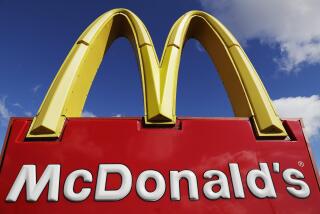Calories, Fat Add Up Quickly if You Don’t Order Carefully
- Share via
To the consumer, fast food is often a pleasing way to satisfy a gnawing appetite. To nutritionists, fast food and its contents have become a subject of frequent interest and some concern.
A prominent example of this concern came within the last few weeks with the publication of an issue of Ross Laboratories’ Dietetic Currents newsletter. The Ohio manufacturer of drugs and artificial infant formula included in its publication tables such things as calorie content, fat, protein and cholesterol information for virtually every menu item sold by major fast-food chains.
The newsletter noted the issue is the third it has devoted to questions on fast food.
“Fast foods are an increasingly important part of the American life style,” Dietetic Currents observed. Factors involved in the growth of the fast-food industry include increases in the numbers of working women, larger numbers of people living alone with no motivation to cook for themselves, an emergence of greater informality in life styles, convenience and even the influence of advertising.
Food With Saturated Fats
“Most fat in fast foods is of animal origin and is, therefore, predominantly of the saturated type--a matter of particular concern to nutritionists,” the publication reported, noting that the fat content of fast-food hamburgers commonly ranges from the equivalent of slightly more than three teaspoons (13 grams) to more than 11 teaspoons (45 grams).
“Many fast-food entrees are high in calories because they are fried,” the report concluded. “On the average, 40% to 50% of the calories from fast-food meals come from this nutrient (fat).”
Eleanor Young, principal author of the study published by Ross Laboratories and a nutrition professor and researcher at the University of Texas Health Science Center in San Antonio, noted the conflict between dietary fat recommendations of government and private agencies (30% to 35% of all calories eaten may be fat). Young calculated that a Burger King Double Whopper with cheese, fries, a chocolate shake and a piece of pecan pie would contain 2,010 calories--itself higher than the recommended total daily caloric intake for many people--of which 936 calories, or 46.7% of the total, is fat.
Calculations by The Times, using a formula provided by Young, showed calorie counts for three commonly consumed meals from Burger King and McDonald’s totaled between 1,054 and 1,173 calories and 42.5% and 47.7% fat content.
By contrast, according to this formula, an Arby’s plain roast beef sandwich with salad and a plain baked potato yielded 697 calories, of which just 21.3% were in fat, and a Wendy’s chicken sandwich on multi-grain bun with a baked potato had just 570 calories, only 18.9% of which was fat.
Young and other nutritionists agreed there is no recommended daily allowance of fat--nor really any way to derive such a figure--but that the overall proportion of fat in one’s total daily diet is a significant issue. “Fast foods are part of our life style,” she said. “They have a legitimate role. They are here to stay but I think the consumer needs to become more sensitive as to how to make informed choices.”
Dr. John LaRosa, dean for clinical affairs and professor of medicine at the George Washington University School of Medicine in Washington, agreed. “Actually many of the fast-food places provide very inexpensive, highly nutritious food,” he said. “But some of it is much too high in terms of animal fat content.”
LaRosa, who is chairman of the American Heart Assn. nutrition committee, said making specific recommendations about how much fat to eat in a fast-food meal is difficult. “A fast-food meal is one of several pieces of someone’s diet,” he said, adding that he would like to see “more of what they’re already doing . . . serving certain kinds of alternatives and marketing the low-fat aspect or the quality of their food. I think this is a healthy sign.”
More to Read
Eat your way across L.A.
Get our weekly Tasting Notes newsletter for reviews, news and more.
You may occasionally receive promotional content from the Los Angeles Times.










